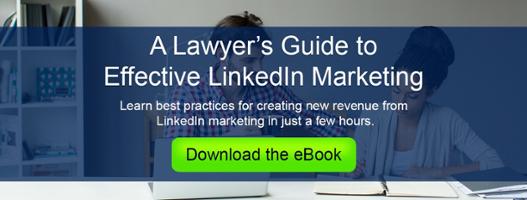Attorneys who make these mistakes on their LinkedIn profiles are damaging their personal brand and losing out on new clients.
With greater frequency, clients will search for your social media profiles prior to retaining your firm’s services.
Those clients are still looking at your firm’s website, but today’s sophisticated buyers know that your website is going to have glossy marketing copy that puts you in the most favorable light. Clients who want to learn more about who you are as a person and, more importantly, what your peers have to say about you, will look to social media for that information.
If your social media profiles are incomplete, it may give the impression that you are out of touch with the rest of the online community. These prospective clients will then wonder what else you may not be up-to-date on: like the law in your chosen practice area.
Regardless of your thoughts about social media, the reality is your business reputation is now directly connected to your social media presence.
Bottom line: if your profile looks bad, then you look bad.
Your reputation is directly connected to your social media presence. Click To TweetHere are five mistakes you can easily avoid on your LinkedIn profile:
1. Having no profile picture
Many lawyers don’t include a picture on their LinkedIn profile. This is one of the biggest mistakes you could make. It makes your profile seem incomplete and could cause a prospective client to completely dismiss your profile.
Like it or not, your photograph is a part of your online brand. Clients want to know who they’re hiring, which includes seeing your face. You might value your privacy, but that should not equate to complete anonymity.
To those attorneys who do have a profile photo, make sure it’s appropriate and professional. This may seem obvious, but many LinkedIn users will throw up any picture on their profile. Your safest bet is to use a high-quality headshot you would use on your firm’s website.
2. Using a generic headline
Headlines are often the most neglected, yet most critical aspects of an effective LinkedIn profile. Don’t ignore this opportunity to make prospects want to click on your profile.
Remember it’s called a headline because it’s supposed to grab attention. When a prospect is scrolling through a list of dozens of attorneys, think about what you can write that will make them take notice.
You should write a headline that stands out and includes specific keywords related to your practice area.
Using a generic headline like “attorney at law” or “associate,” won’t set you apart from other lawyers, and may even prevent your profile from appearing in search results altogether. For example, a search for “lawyer” on Linkedin would yield 388,984 results, so a plain headline is likely to get lost.
3. Not customizing your URL
Your LinkedIn profile is a representation of you; therefore, you should take steps to make it as personalized as possible.
Your LinkedIn profile is a representation of you; therefore, you should make it personalized. Click To TweetIf you go into your settings, you can edit your URL to LinkedIn.com/in/FIRSTNAMELASTNAME.
It’s a simple, easy way to optimize your profile and make it look more sophisticated. You should also take that URL and put it on your business card so you can increase your LinkedIn network.
4. Listing your “specialties” in your summary
First of all, this is a huge mistake attorneys make on LinkedIn because listing that they have “specialties” may violate the ethical rules in their jurisdiction. For example, the New York State Bar Association Committee on Professional Ethics requires all New York attorneys to stop listing specialties on their profiles.
Additionally, listing “specialties” or “practice areas” tells someone next to nothing about what sets you apart from other lawyers. It’s good to know you can handle divorce and custody cases, but what makes you any better than the next family law attorney? Give prospective clients details, and they’ll give you their case.
5. Writing a weak summary
Leaving the summary section blank on your profile is a common and deadly mistake attorneys make on LinkedIn. This is your single biggest opportunity to use your profile to tell prospects who you are. If you don’t define yourself, then others will do it for you.
When you sit down to write your summary, the most important thing to keep in mind is that your summary shouldn’t actually be a summary. It should be a story.
The best tool you have to convey what differentiates you from the competition are the stories you have from your practice. A story can help you sound more relatable to clients and humanize your personal brand. Although LinkedIn is a platform for professionals, that doesn’t mean you a shouldn’t showcase a little bit of your personality.
Write a summary that uses a story to highlight what your experience in your profession has been like so far, how you’ve grown in your professional career and where you see yourself in the future.


